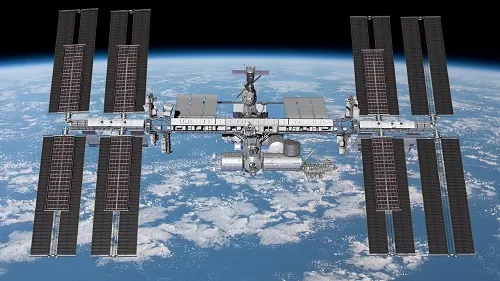
Boeing to give space station a solar boost
Jan 11, 2021

Boeing is set to enhance the International Space Station's solar power capabilities through a groundbreaking initiative. The company aims to replace aging solar arrays with advanced, high-efficiency panels that can significantly increase energy production. This upgrade is essential for supporting the growing demands of scientific research and technology demonstrations aboard the station. With a focus on sustainability and innovation, Boeing's project not only promises to extend the operational life of the space station but also demonstrates a commitment to advancing space exploration while ensuring a reliable energy supply for future missions.
Boeing has announced an exciting initiative to enhance the International Space Station's (ISS) energy capabilities by integrating advanced solar technology. This project is aimed at improving the station's power supply, enabling it to support more research and experiments in the realm of space exploration. The enhancement is not just a boost for the ISS but also a major step forward for "Boeing" and its role in advancing space technology.
Understanding the Solar Upgrade
The solar upgrade will involve the installation of new solar arrays that are designed to generate significantly more power than the existing ones. These upgraded arrays will harness solar energy more efficiently, providing the ISS with a sustainable energy source that is crucial for its operations. The decision to enhance the solar power capabilities comes as the ISS faces increasing demands for energy due to expanded scientific endeavors and the need for more power-hungry equipment.
The Importance of Solar Energy in Space
Solar energy is pivotal for space missions. It provides a renewable source of power that is essential for the operation of satellites and space stations. For the ISS, solar energy is not only used for powering its systems but also for conducting various scientific experiments. The new solar arrays from "Boeing" are expected to double the energy output, thereby increasing the station’s capacity to support long-term missions and advanced research.
Technical Specifications of the New Solar Arrays
The new solar arrays will feature cutting-edge technology, including:
| Feature | Details |
|---|---|
| Type of Solar Cells | High-efficiency multi-junction solar cells |
| Power Output | Expected to double the existing power generation |
| Weight | Lightweight materials to minimize launch costs |
| Durability | Designed to withstand harsh space conditions |
These features highlight "Boeing's" commitment to innovation and sustainability in space technology, providing the ISS with a robust energy solution for years to come.
Benefits of the Solar Upgrade
Upgrading the solar arrays brings numerous benefits:
- Increased Energy Capacity: The new arrays will significantly increase the ISS’s energy capacity, allowing for more experiments and improved living conditions for astronauts.
- Enhanced Research Opportunities: With greater energy availability, researchers will be able to conduct a wider range of experiments, potentially leading to groundbreaking discoveries in various scientific fields.
- Long-term Sustainability: By harnessing solar energy more efficiently, the ISS can reduce its reliance on other energy sources, making it more sustainable in the long run.
Future Implications for Space Exploration
The solar upgrade is not just an isolated enhancement; it represents a broader trend in the industry towards sustainable practices in space exploration. As missions become longer and more complex, the need for reliable and renewable energy sources becomes ever more critical. The technology being developed for the ISS could pave the way for future missions to Mars, the Moon, and beyond, where energy generation will be a key challenge.
Furthermore, "Boeing's" advancements in solar technology could influence commercial space ventures and satellite operations, as companies seek to improve their energy efficiency in orbit. The lessons learned from the ISS solar upgrade may well inform the design of future spacecraft and space habitats.
Conclusion
Boeing’s initiative to upgrade the solar arrays on the International Space Station marks a significant advancement in space technology. By boosting the ISS's energy capabilities, "Boeing" is not only enhancing current operations but also setting the stage for future innovations in space exploration. As we continue to push the boundaries of what is possible in space, sustainable energy solutions like this will play a crucial role in ensuring the success of long-term missions.
In conclusion, the collaboration between advanced technology and sustainable practices is essential for the future of space exploration. As "Boeing" leads the charge with its solar boost for the ISS, the implications for the future of human presence in space are profound and far-reaching.
Related Articles

Explore Thailand: The Best Islands to Visit for Paradise, Adventure, and Relaxation

The Ultimate Guide to the Best Islands in Thailand for Your Next Getaway

Do babies need passports? How to get a passport for a newborn

How to get a U.S. passport fast: here’s how to expedite the process

What is Mobile Passport Control: 5 reasons why you should use it

SENTRI vs. Global Entry: A detailed guide

Do you need a passport to go to the Bahamas? Let’s find out

Do you need a passport to go to Mexico? A detailed guide

Do you need a passport to go to Canada? We got the answer

Do You Need a Passport for a Cruise: An Essential Travel Guide

Booster Seat Requirements: All the Rules to Follow in Your Rental Car

What Are the World’s Most Powerful Passports, and How Does Yours Rank?

How to Take a Passport Photo at Home: A Helpful Guide

You've got to have heart! Southwest's new livery

Your opinion: Should water be free on low cost carriers?

Young women bolder than guys as solo travellers
